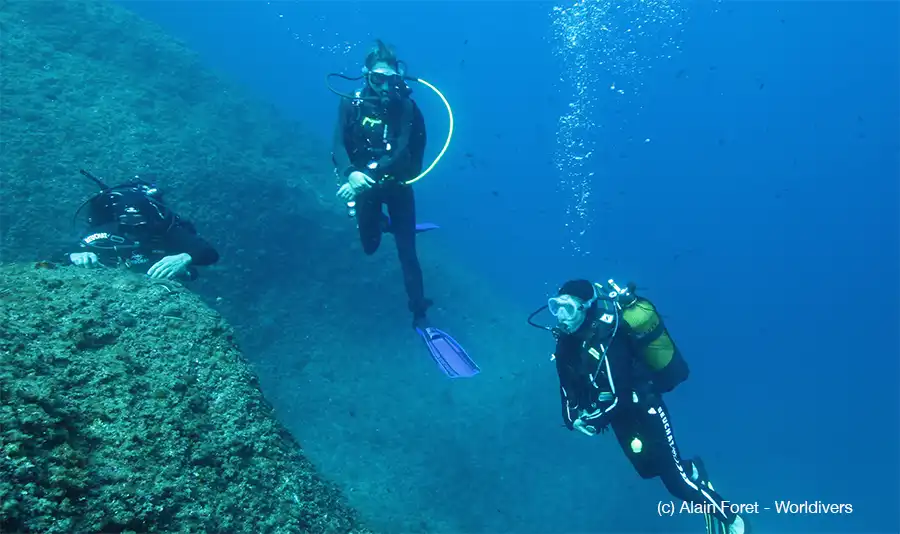Nitrogen narcosis
Ref. 25-029/CMAS/TC - 18 August 2025

Nitrogen narcosis
Narcosis is a nervous system disorder caused by nitrogen (N2) during air diving. It is reversible without consequences as soon as the depth is less than 40 m [1].
Narcosis is ‘progressive from 35 to 60 m depth when diving with air, with no threshold effect, and systematic beyond 60 m’ [1] (PpN2 > 5.6 ATA).
Physiological limit: 60 m.
Consequently, a distinction must be made between:
Narcosis is ‘progressive from 35 to 60 m depth when diving with air, with no threshold effect, and systematic beyond 60 m’ [1] (PpN2 > 5.6 ATA).
Physiological limit: 60 m.
Consequently, a distinction must be made between:
- The effects of narcosis, which can appear at depths of 35 m or more;
- Narcosis crisis, which can occur during deep dives beyond 40 m and especially beyond 60 m, the physiological limit.
Effects of narcosis
It is commonly accepted [1] that the first signs (not the crisis) can appear at depths as shallow as 30 m and that they are often masked, with the diver unaware of anything unusual.
These signs include a decrease in reasoning, concentration, or attention span, as well as short-term memory problems (e.g., checking your pressure gauge too often, forgetting that you have already done so) .
Taking certain medications can increase the likelihood of narcosis, even at shallow depths. Read the instructions carefully and, if necessary, ask your doctor for advice.
The effects of narcosis should not be confused with a narcosis crisis; they can be controlled by following the prevention advice.
These signs include a decrease in reasoning, concentration, or attention span, as well as short-term memory problems (e.g., checking your pressure gauge too often, forgetting that you have already done so) .
Taking certain medications can increase the likelihood of narcosis, even at shallow depths. Read the instructions carefully and, if necessary, ask your doctor for advice.
The effects of narcosis should not be confused with a narcosis crisis; they can be controlled by following the prevention advice.
Narcosis crisis
“Narcosis crisis” can occur during deep dives, sometimes beyond 40 to 50 m and certainly beyond 60 m [1] (PpN2 > 5.6 ATA).
It leads to noticeable changes in behavior:
It leads to noticeable changes in behavior:
- Slow thinking is the first symptom.
- The diver has difficulty concentrating and simple actions (such as looking at their instruments) require an effort of concentration.
- Some individuals engage in intense self-dialogue and have fixed, sometimes morbid ideas.
- Others, on the contrary, are euphoric. They become enthusiastic about everything and anything, and even the smallest pebble becomes of paramount interest.
- In extreme cases, some divers are no longer able to react appropriately to circumstances. Vision or taste disorders may appear. Some can no longer tell up from down: believing they are ascending, they may descend even deeper.
Prevention of narcosis crisis
Apart from the need to have undergone training appropriate to your depth of evolution:
- Do not exceed a rate of 30 m/min when descending;
- Reduce this rate from 30 to 35 m depth;
- Gradually progress to dives beyond 35 m, which means diving regularly to reach this depth zone.
Educational advice
Do not confuse the possible early signs of narcosis with a narcosis crisis.
Keep signs of narcosis in proportion, without exaggerating the risks of a crisis below 50 to 60 m.
Keep signs of narcosis in proportion, without exaggerating the risks of a crisis below 50 to 60 m.
[1] Louge P., De Maistre S., Rynier J.-C., Les accidents toxiques ou accidents "biochimiques" in Blatteau J.-E., Coulange M., Méliet J.-L, Médecine de la plongée, Medsuhyp, Elsevier Masson, 2024, p. 119.
[2] Rostain JC, Lavoute C. Neurochemistry of Pressure-Induced Nitrogen and Metabolically Inert Gas Narcosis in the Central Nervous System. Compr Physiol. 2016 Jun 13;6(3):1579-90. doi: 10.1002/cphy.c150024. PMID: 27347903.
[3] Rostain JC, Lavoute C, Risso JJ, Vallée N, Weiss M. A review of recent neurochemical data on inert gas narcosis. Undersea Hyperb Med. 2011 Jan-Feb;38(1):49-59. PMID: 21384763.
[2] Rostain JC, Lavoute C. Neurochemistry of Pressure-Induced Nitrogen and Metabolically Inert Gas Narcosis in the Central Nervous System. Compr Physiol. 2016 Jun 13;6(3):1579-90. doi: 10.1002/cphy.c150024. PMID: 27347903.
[3] Rostain JC, Lavoute C, Risso JJ, Vallée N, Weiss M. A review of recent neurochemical data on inert gas narcosis. Undersea Hyperb Med. 2011 Jan-Feb;38(1):49-59. PMID: 21384763.









